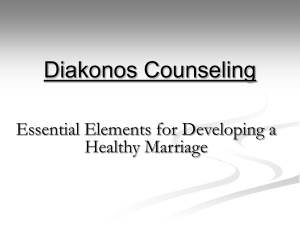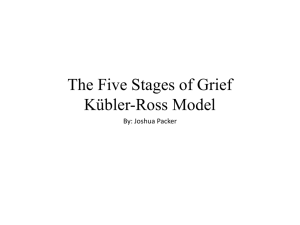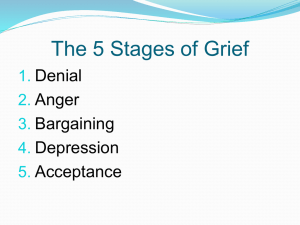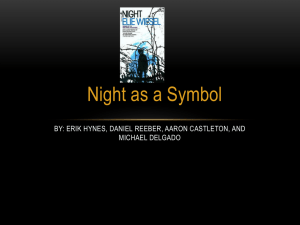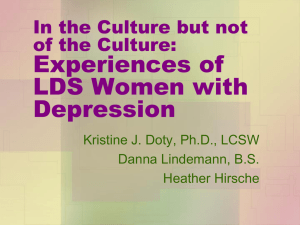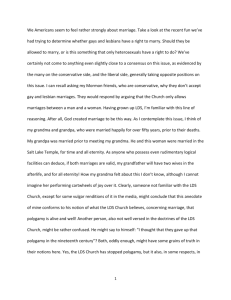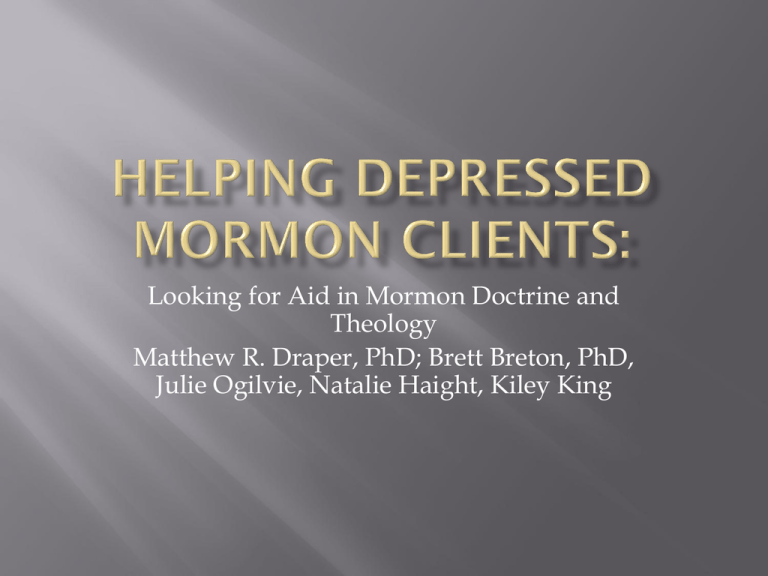
Looking for Aid in Mormon Doctrine and
Theology
Matthew R. Draper, PhD; Brett Breton, PhD,
Julie Ogilvie, Natalie Haight, Kiley King
Mormonism does not cause depression
In a meta-analysis:
4% of studies find a negative relationship between
Mormonism and mental health measures
24% find no relationship
71% find a positive relationship
This compared to an overall 51% positive relationship
between non-Mormon religiosity and mental health
(Judd, 2006; 2012)
The negative results relative to Mormonism entailed issues
with anxiety, authoritarianism, and
ethnocentrism/prejudice (Bergin, et. al, 1994)
Utah is #1 in antidepressant medications
Ergo, Mormonism causes depression
Logical fallacy of correlation/causation
Active LDS are in the minority, even in Utah County
(Knowlton, 2012)
Utah is also #1 in antibiotics, analgesics, and antiinflammatory medications (Judd, 2006)
Mormons are much less likely to “self medicate” with
alcohol or other drugs
In addition, when education is controlled for, the
relationship between anti-depressant use and
Mormonism vanishes (Heaton, Bahr, & Jacobsen,
2004)
The suicide rate among active LDS are
dramatically lower than inactive or nonMormon (Hilton, Fellingham, & Lyon, 2002)
Divorce rates amongst active LDS who are
“sealed” in their temples are half to one-fifth
the national average (Lobdell, 2000).
So, if Mormonism causes depression, then we
should see much higher suicide and divorce
numbers
Some argue that the numbers for Mormons are
due to cultural pressure to mask misery and to
fake happiness
This is called a “Desirability effect”
It is controlled for in many studies
In fact, the deeper you dig, the better it seems that LDS
folks are doing
Physical health, mental health, low delinquency among
children, low rates of addiction to illicit substances, etc.
Anecdote about Mennonites and depression
The columns represent a combination of
mental-health issues measured in a metaanalysis (Judd, 2006)
Combining mental health diagnoses, addiction, and
suicide
“Active” is defined as believing in the faith +
attending
“Inactive” is defined as not believing in the
faith + not attending
“Non-LDS” is self-explanatory
From this meta we can see that less-active LDS
have greater difficulties
The chicken/egg conundrum is unclear
We coined the phrase “Reactionary
Mormonism” to describe anecdotal
observations reflected in empirical research
Mormons: No wine at all with dinner (anathema to
think otherwise)
Non-Mormons: A glass of wine with dinner
Inactive LDS: A bottle of wine with dinner
We seek to help with two issues:
Even active LDS clients suffer
And often their faith informs the manifestation of their
suffering
Less-active LDS clients suffer
And their former faith often informs the manifestation
of their suffering
What follows are clinical observations followed
by conversation with LDS theologians about
these clinical cases that greatly helped resolve
some of the client’s core issues
Careful when you read research
Most researchers lump all “Mormons” together into
one group
From active and devout to actively atheistic
When you parse those groups out, however, many of
the outcomes across levels of devotion are fascinatingly
different
For example: numbers are better for active LDS, EXCEPT
actives have higher pornography and masturbation rates,
and less-actives have a better sex life and lower rates of
masturbation and pornography use
This list is neither comprehensive nor
exhaustive, but common in our experience
when working with people from an LDS
background:
Suffering
Perfectionism
Anger
Sexuality
A common belief from LDS culture is that
“righteousness” (in terms of strict obedience to
a long list of commandments) is a downpayment or monthly subscription to happiness
and freedom from suffering
Story of “Jill”
After desperate attempts to find the sin to explain
her suffering could not find one
Common misinterpretation of Alma 41: 10 “Behold,
wickedness never was happiness”
Misinterpreted as “if I’m unhappy, I must be wicked”
Well-meaning LDS leader confirmed her belief
After much soul-searching together they realized that Jill’s
suffering must be due to a lack of faith, and with sufficient
faith her depression would remit
After months of trying to increase her faith, her depression
did not remit
Ashamed, she quit attending her beloved congregation
Helping her understand:
Living one’s religion (as an LDS) does not, and
should not guarantee a life without problems
“A life without opposition, sometimes bitter and often
hard to bear, would be contrary to the plan of salvation
by ancient and latter-day prophets” (Judd, 2006)
How many devout men and women in scripture
died content, of old age, surrounded by loved ones?
Were they wicked, or lacking in faith?
Adding guilt and shame to suffering only
makes the suffering unnecessarily worse.
“Opposition in all things” (2 Nephi, 2:11)
Later in that same verse: “Wherefore, all things must
needs be a compound in one”
Life and death, happiness and misery
Suffering and Joy co-constitute one another
Hence, do not feel guilty about your suffering for it always
already exists in relation to joy, and makes joy possible
Refer to scripture about the importance and nature of
suffering: D&C 109: 76 – reaping joy after suffering;
D&C 122:7 – all misery is made good
The importance of suffering and the role of
savior/comforter 1 Cor. 9:27; 11:30–33; 2 Cor. 4:16–17;
12:7
Indeed, the purpose of suffering is to give the sufferer a
reason to pray, and to teach compassion (Robinson,
1992; Draper, 2002)
Jill suffered because of her suffering (shame compounded
her depression)
As she came to realize that she was not sinful because of her
depression, she ceased feeling ashamed of it
Because of her suffering, she could compassionately relate to
others
Because of her suffering she could pray to her God for
support with a clear conscience
No, her depression didn’t magically vanish, but she went
back to living her life again
Salvation can come through damnation 1 Cor, Chapter
5
For “Erika”: “How can your damnation lead to
salvation?”
For her it did not, but as she worked on it, she found that
her suffering gave her compassion and perspective to help
others
Her suffering did not “save” her, but it continually allowed
her to help many
And she derived great meaning from compassionately caring
for others
At that point, she had no desire to lose her suffering
Perfectionism causes more problems than it
solves, relative to mental health
LDS Theologians have been aware of this for
some time and have commented on it
repeatedly, for example:
“Those suffering from perfectionism tend to be
wonderful, contributing, and effective people,
and yet may feel that no matter what they do, it
is never enough. These good people suffer
from exaggerating their minor mistakes,
weaknesses, or shortcomings to the point that
they may become dysfunctional” (Samuelson,
2006).
Mary presented with chronic GAD and panic
without agoraphobia
The content of her anxiety centered around having
to obey “every commandment”
She became so crippled trying to obey every
“commandment” that she could no longer work or go
to school
I had her count all of the commandments she tried to
obey every day, and the list was staggering
When gently confronted about this, she replied “in
our church we are commanded to be perfect, and to
be perfect you have to obey all of the
commandments”
Some fundamentally misunderstand Matthew
5:48 “be ye therefore perfect”
As far as we can tell, the word closest to what Christ
actually said was “telios”(Luow & Nida, 1988)
Telios means “mature” and “whole” and “finished“
The listeners at the time would have been reminded
of the “Shema”(Deut. 6: 4-5)
Telios = perfect = “God is one Lord” (Danker, 2000).
People can love God and trust him because he is
whole, complete, and mature (Draper, 2013).
“Be ye therefore perfect” means be whole,
complete, and mature so other people can trust
you and love you without risk
Note it has nothing at all to do with obeying every
supposed commandment
Careful not to throw the commandments out, if we
break certain commandments it would be hard to
trust/love us
Mary very defensive about the commandments and
terrified that my position meant licentiousness
Mary and I developed a plan for her to practice
being loveable and trustable
She began to re-connect with others slowly,
eventually got a part-time job and eventually got
back into school
Interestingly, she found that her previous
understanding of “perfect” interfered with her Telios
If someone was tattooed or smelled if cigarette smoke
she could not be around them, terrified that their
imperfection would rub off on her
When she focused on becoming Telios, however, she
found compassion
Case of Rachel
Mother of two, working almost full-time going to
school full-time
All childcare and home duties were her responsibility
Husband did not help
Incestuous pressure from adoptive brothers
Perfectionistic, critical mother
Presents with suicidal depression
Which terrified her
Didn’t tell anyone
Klein, an expert in suicide and depression once
told me that “Depression is anger that cannot
be let out or expressed”
Rachel clearly had things she could feel angry
about, and most people would
When I shared this with her, she stated “but in
our church we are told we can never be angry”
Read with her John 2: 13 – 15
You destroyed my testimony! She yelled.
“To be angry is to yield to the influence of
Satan” (Monson, 2009)
In addition: “We have all felt anger” in the
same talk, which could imply that we have all
yielded to the influence of Satan
Monson means abuse and being governed by
our anger rather than vice-versa
Well, of course, but look at what he means
Basically, the sin of wrath
The feeling of anger is not a problem
Eph 4: 26 - 27 “Be ye angry, and sin not: let not
the sun go down upon your wrath. Neither
give place to the devil”
Be angry! (Paul validates the feelings of the saints in
Ephesus)
BUT! He counsels that even though we are angry to
resolve the source of our contention and not let it
fester
And anger is the emotion that motivates us to resolve
problems in some cases
“Any emotion serves a function. Although
most people think of anger as destructive, it
can have positive effects. A quick, mild
‘constructive’ display of anger on your part
tells your friend or romantic partner ‘hey, that
hurt! Don’t do it again!’” (Kalat & Shiota, 2007)
“Reproving betimes with sharpness” and later
“showing forth afterwards an increase of love”
We would not reprove sharply if we did not feel
anger
That’s different from abusive wrath
Captain Moroni: “I am in my anger”
Jesus Christ and the money changers
Heavenly Father (23 references to God’s wrath
in the D&C alone and no references to God
loving His children in that book)
But what we do about it, can be
However, never allowing ourselves to feel
anger or to allow it to motivate us to change
our world or our relationships stagnates and
poisons us
“Anger can obstruct, erode, or even demolish
relational intimacy . . . When it is engaged in, at
least to some degree, in the context of spiritual
practice. As much as anger’s fire can
injuriously burn, it can also illuminate . It all
depends on what kind of relationship with
anger we cultivate” (Masters, 1998 p. 1)
Rachel came back
Worked through with her the above ideas
Started to confront the lack of help from husband
Started to confront incestuous pressure from
brothers
Started to confront her critical mother
LOTS of anxiety about doing so at first
Gradually, however, her relationships changed for the
better
And her depression remitted
Common, an American problem, not a
Mormon problem
But Mormons put their own twist on this issue
She’s a surfer girl from Cali
How she met her future husband
Conversion
Whirlwind romance
Temple marriage
Complete lack of sexual intimacy in the marriage
Pornography found
“Barbie” didn’t have a problem with pornography per
se, but did have a problem that it interfered greatly
with her marriage
Ken raised in a home where the subject of sex
was relegated to shame-based silence
Ken loved Barbie and did not want to shame
her
But the girls on the internet he did not love,
therefore had no problem engaging in “shameful”
behaviors with them
To Ken, sex = inherently bad, the body = inherently
filthy/corrupt
The fetishization of pixels, the pornographication of
marriage
Ken could not (or would not) comprehend a
sex-affirming doctrine
In our third session he turned to Barbie and
said “You can never be for me what the girls on
the internet are”
“That’s NOT Mormonism. I’m a returned
missionary, you’re wrong” he said
Meaning, she could never arouse him
That was his last session
But not all endings are sad
Fear Regarding Discussion of Sex
If you talk about it, fornication!
Absence of Healthy Discussion
Confusion
•
i.e. “petting/necking”
Story of wet dream / masturbation mix-up
Consequences of not having healthy discussions:
•
Children turn to other sources for information:
Other children
The Internet
Pornography
“Many marriages have been wrecked on the dangerous rocks of
ignorant and debased sex behavior, both before and after
marriage. Gross ignorance on the part of newlyweds on the
subject of the proper place and functioning of sex results in much
unhappiness and many broken homes.
“Thousands of young people come to the marriage altar almost
illiterate insofar as this basic and fundamental function is
concerned. …
“If they who contemplate this most glorifying and intimate of all
human relationships [marriage] would seek to qualify for its
responsibilities. … if they would frankly discuss the delicate and
sanctifying aspects of harmonious sex life which are involved in
marriage, … much sorrow, heartbreak, and tragedy could be avoided.”
(You and Your Marriage, Salt Lake City: Bookcraft, 1960, pp. 22–23,
73.)
Alma 39: 3 -5
Adam and Eve
Born naked signifying there is nothing wrong about
the human body in God’s eyes
Genesis 2: 18
Greatest sin second to murder is “not tending to the
ministry” and “boasting”, not the sexual indiscretion
Help meet is two words….where helpmeet basically
means slave, help meet means the companionship of
Eve was necessary to Adam’s salvation
We should be responsible for ourselves….
i.e. story bishop enforcing “panty hose rule”
Moses 3:24
“Therefore shall a man leave his
father and his mother, and
shall cleave unto his wife;
and they shall be one flesh.”
Spouse can be a great support and help to
those struggling with depression
Physical intimacy also releases serotonin
“Intimate relations were designed
by the Lord as a sacred opportunity
to renew marriage covenants,
provide therapy, and keep you two
in love. It is essential in a stressful
world that the two of you enjoy
your physical and emotional
relationship.” (Douglas Brinley, Jan.
2012)
“Several years ago when I was a young
missionary and had just received a new companion,
we met a Protestant minister who invited us in out of
the cold. After exchanging points of view on various
topics, he asked us, “And what is the Mormon
attitude towards sexuality?”
I choked on my cup of hot chocolate, but my new
companion seemed unmoved. “Well,” said the
minister after a moment of silence, “could you please
tell me the Mormon philosophy toward sexuality?” I
was tongue-tied and believed my new companion
knew next to nothing on the matter.
However,
when my companion realized that I didn’t have an
answer, he finally said, “Sir, we believe in it.” It has
been more than twenty years since that time, and I
have been asked the same question by numerous
students, friends, professional people, and LDS
members and nonmembers alike. And still, I haven’t
yet been able to come up with a better answer than
the one given by my supposedly naive companion:
“We believe in it.”
But we also believe in the good that can be
derived from the appropriate use of intimacy in
marriage. We are well aware of the joy and unity that
can come to a married couple when this particular
dimension of the marital relationship is nurtured.”
(Brent A. Barlow, Sept. 1986).
Barlow, B.A., (1986, September) They Shall Be One: Thoughts on Intimacy in Marriage. Ensign.
Bergin, E. Payne, I., Jenkins, P., and Cornwall, M. “Religion and
Mental Health: Mormons and Other Groups,” In M. Cornwall, Tim E. Heaton, and
Lawrence A. Young (eds.), Contemporary Mormonism: Social Science Perspectives,
Urbana and Chicago: University of Illinois Press, 1994, p.139.
Colvin, G. Mormons and their ‘Sex Talk’. Retrieved January 25, 2013, from
<http://www.patheos.com/blogs/kiwimormon/2012/01/mormons-and-their-sex-talk/>
Danker, F. W. (2000). A Greek-English Lexicon of the New Testament and Other Christian Literature, 3rd ed.
Chicago: University of Chicago Press.
Draper, R. (2002). A Fulness of Joy. Covenant Communications, American Fork, UT.
Draper, R. (2012). Telios and the Purpose of Perfection. Personal communication with an LDS theologian.
Heaton, T., Bahr, S., and Jacobson, C. A Statistical Profile of Mormons: Health, Wealth, and Social Life, Lewiston
(New York): Edwin Mellen Press,
2004, pp. 146 (drug use), 30-31 (education), and 157-158 (physical health).
Hilton, S., Fellingham G., and Lyon, J. (2002). “Suicide Rates and Religious Commitment in Young Adult
Males in Utah,” American Journal of Epidemiology, 155:415
Judd, D. “Religiosity, Mental Health, and the Latter-day Saints: A Preliminary
Review of the Literature (1923-95),” in J. T. Duke (editor), Latter-day Saint Social Life:
Social Research on the LDS Church and its Members, Provo (Utah): Religious Studies
Center, 1998, p. 473.
Judd, D. (2006). Religion Mental Health, and Latter Day Saints. Presentation given at the Weekly Forum Address
of Brigham Young University. Provo, UT.
Kalat, J. W. & Shiota, M. N. (2007). Emotion. Belmont CA : Thomson Wadsworth.
Knowlton, D. (2012). Religions participation rates in Utah. Active Mormons are the minority. Personal
communication with an expert on Mormon culture and an anthropologist of Mormonism.
Lewis, C.S. (1960). Mere Christianity. The Macmilan Company: New York.
Lobdell, W. (2000). “Holy Matrimony: In Era of Divorce, Mormon Temple Weddings
Are Built to Last,” Los Angeles Times, Saturday, April 8, p. 6.
Louw, J., and Nida, E. (1988). Greek-English Lexicon of the New Testament Based on Semantic Domains. New York,
ABS.
Masters, R. A. (1998, Fall). Fire is Also Light. ReVision, 21, 42-50.
Maxwell, N. A. (1996). If thou endure it well. Bookcraft: Salt Lake City.
Robinson, S. E. (2008). Believing Christ. Deseret Book Publishing: Salt Lake City.
Robinson, S. E. (1995). Following Christ. Deseret Book Publishing, Salt Lake City.
Samuelson, C.O., (2007, October) I Will Not Leave You Comfortless. Ensign.
Samuelson, C.O., (2006, January) What Does it Mean to Be Perfect? Ensign.


